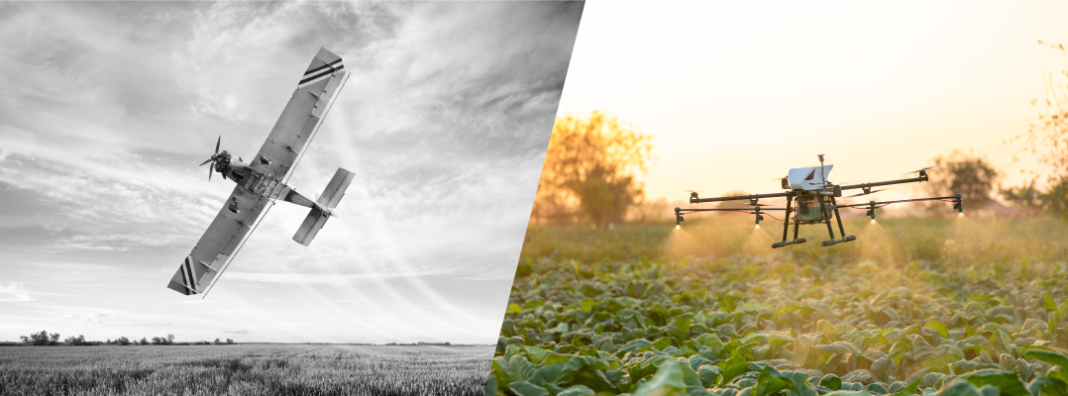
Modern farming is beginning to look more like a Star Wars movie rather than Little House on the Prairie as farmers start to implement drones, robotics, and artificial intelligence. The broader term for these innovations is “precision agriculture.” These new technologies can perform harvesting, pest control, and other essential duties with greater accuracy and efficiency.
Unmanned Aerial Vehicles (UAVs) are one of the most effective technologies used on farms today. These drones not only help farmers produce more food, but they also do so with greater efficiency, reducing environmental damage, and revealing real-time information about their fields.
To support our ever-hungry world, we need our farms to become more efficient and automated. The adoption of UAVs on farms helps us meet this goal. We can aid their adoption through greater investment and fewer policy barriers. By understanding how UAVs benefit farmers, and which challenges they solve, it becomes clear why UAVs are one of our most crucial innovations.
The promise of data technology: Less resources for better results
If your grandfather or great-grandfather was a farmer, chances are you are not. But unlike your grandfather, you have access to a wide assortment of fresh produce year-round. Innovations in agricultural technology not only diversify our access to food but allow fewer people to work on farms while still producing enough food to feed America. Much of that is due to the mechanization and industrialization of agriculture.
The number of farms in the United States has fallen by over 60% since 1900, while the average farm size has increased by over 65%. A USDA census report shows that total factor productivity has more than tripled over the same period. That means that even as fewer Americans are working in agriculture, we can produce more than ever before thanks to new advancements.
UAVs assist farmers in three main areas: pest control, irrigation, and imaging.
Pest Control
Farmers tend to rely on generalizations when dealing with weeds and pests and often apply pesticides to unaffected areas. Instead of scouting the field to identify problem areas, it is much easier to spray an entire field. This method covers all problem areas, but it also wastes material by applying pesticides to unaffected areas.
To reduce these costs and use fewer pesticides, farmers can instead rely on UAVs to identify pests in specific areas, and spray these pests with greater precision. High saturations of pesticides pollute the surrounding soil and water which can damage native vegetation and contaminate the groundwater we drink.
Using a UAV to create a map of the most dense areas of weeds and deploying a UAV to apply pesticides to these areas saves time, material costs, and environmental damage from overspraying.
Irrigation
Water represents another significant resource expended on farms that can be better allocated through the use of UAVs. Farms use almost 70% of the world’s freshwater. Of this ocean that we spend on farms, only 65% of it is actually used by crops. Farmers lose the remaining 35% in distribution or application.
Irrigation systems are like pesticides in that they are usually applied in generalizations. Farmers can now equip UAVs with sensors to instead determine the water needs of crops. This enables UAVs to apply the correct amount of water to the areas that need it most.
For example, normalized difference vegetation index (NDVI) sensors measure the photosynthetic activity of crops and communicate their moisture stress. Crops that have higher temperatures communicate moisture stress through an inability to transpirate, which UAVs can detect using thermal sensors.
Instead of wasting water—a resource already threatened by climate change—farmers can employ UAVs equipped with NDVI sensors to target the driest areas in the field and water with efficiency.
Imaging
UAV imaging techniques empower farmers to estimate fertilizer requirements as well as the health and expected yields of their crops with accuracy. Instead of relying on their eyes, farmers can now rely on the eyes of UAVs which can see through a spectrum of lenses.
Through the creation of detailed maps, farmers can identify problematic areas or the state of their crops through their reflectivity. These sensors not only perform the work that is in high demand, but also help expand the toolset and knowledge of farmers.
Before the introduction of sensors, farmers needed to rely on visual intuition. Farmers then traded visual intuition for satellites and hand-held sensors. Farmers are once again adopting more reliable methods of image analysis and prediction with UAVs. The maps created by UAVs provide information at the centimeter level and are much more accurate than satellites.
Challenges like the variation in sunlight and cloud cover have made it difficult to compare aerial images taken by drones, but Downwelling Light Sensors (DLS) provide a solution. A DLS sensor can detect the amount of sunlight when capturing an image. Farmers can then use this data to standardize the images, ensuring they are comparable.
Many UAV operations can be even further automated through planned pathing routines. This means that a farmer can specify a time at which a drone—or fleet of drones—carries out an automated task like capturing an aerial image. Some automated processes are so complex that they include both the capture and analysis of data on a farm.
One example and implementation of this process is American Robotics and their products. Their autonomous “Scout” drones allow farmers to pilot from a smartphone or tablet. The analysis of this data is also automated through American Robotics software, providing farmers with real time statistics related to their farm.
This automation arrives at the perfect time due to current labor shortage concerns. In 1950, we had over seven million family farmers in the United States and two million hired contractual farm workers. That number is now down to two million family farmers and one million hired workers.
Today’s farmers are older and hire more seasonal labor during planting and harvesting periods. But since the 1990s, even immigrant labor has decreased in the United States by more than 30%. Farmers are relying less on labor and protecting against shortages by using drones and other precision agriculture technologies instead of farmhands.
Challenges to drone adoption
Regulation
Existing drone regulations limit the scope of what farmers can use UAVs to do.
Sending UAVs on automated routines may seem attractive to many farmers, but such methods defy Federal Aviation Administration (FAA) regulations. Rule 107.31 of the FAA Federal Rules and Regulations section titled “Small Unmanned Aircraft Systems” states that the pilot of an unmanned aerial vehicle must keep direct visual observation of the drone throughout the entire flight.
This rule prevents farmers from creating automated flight schedules for their drones and makes the process more tedious. The FAA has shown flexibility around this rule and has allowed specific companies to bypass it in their operations.
American Robotics, mentioned earlier for their services in both data collection and analysis, became the first commercial drone company to receive approval from the FAA to fly their drones without needing operators on site. However, farmers that do not associate with American Robotics face this barrier if they want to conduct UAV operations remotely.
Automation benefits small farmers who are unable to conduct data analysis and hire pilots. Allowing small farmers to automate and pilot their UAVs remotely lessens the costs of adopting this crucial innovation. Price is already a barrier to UAV adoption for many farmers. Policymakers should avoid unnecessary policies that further discourage technology use that could benefit everyone.
Removing FAA rule 107.31 would allow any farmer that operates UAVs to automate.
Cost
The cost barrier is another significant hurdle for agricultural producers. The DJI Agras MG-1 is a popular agricultural spraying drone. At the time of writing, the drone is available to purchase from various online wholesalers at around $15,000. Since it is a less-complex drone without imaging sensors and complex software, the DJI Agras is one of the cheapest UAVs on the market.
Farmers wanting to measure more complex data like crop vitality with normalized difference vegetation index (NDVI) sensors might end up spending upwards of $50,000 per drone. And this is only the hard cost of purchasing a drone. The variable costs associated with operating and maintaining UAVs make it impossible for small farms to use the most innovative benefits.
Collecting data is only the first step in the process of utilizing UAVs. Farmers also need to conduct detailed data analysis to create functional maps and produce actionable insights. The datasets that UAVs capture are large and expensive to store. They are also difficult to interpret without an experienced analyst. This is especially limiting for small-scale farmers, who do not have the technical expertise or money to hire specialized analysts.
One avenue to avoid these upfront costs is to instead rent these equipment or services. Companies like Parabug, American Robotics, and UAV-IQ, exist as third-party pest control and data analysis services, and market their products to smaller farms. Through PrecisionHawk’s “Drone Pilot Network” UAV operators can list their services and connect with farmers in need of experienced drone pilots. This allows farmers to contract this high-skill labor only when they most need it. These outsourcing methods shield small-scale farmers from the costs related to conducting analysis and upgrading UAVs as technology advances.
To promote implementation of UAVs in fields, both small and large, more attention and investment should be devoted toward research, specifically geared to making UAVs more efficient and affordable. The precision agriculture market size has grown from $3.6 billion to now $7.5 billion this year, and is projected to reach $9.7 billion by 2024. As continued investment pours into this market, UAV technology will become more advanced and accessible.
Conclusion
In 1900, over 41% of the total workforce consisted of agricultural labor. Since then, the percentage of farmers in the workforce has shrunk to less than 2%. Farms are becoming larger, more specialized, more productive, and need less labor. Although technological innovations have enabled this growth and transformation of the industry, the challenge of feeding a growing population amid increased environmental stresses means we can’t rest comfortably yet.
The United Nations predicts that our global population will reach almost 10 billion people by the year 2050. A report from the Food and Agriculture Organization of the United Nations estimates that food demand will increase 50% by 2050. Feeding the world has always been a challenge, but many factors, including labor shortages, shifting climates, and land scarcity mean it is necessary to invest in technologies that will continue to build our capacity to grow crops amid changing circumstances.
Farming has changed a lot since humanity first adopted the practice. To meet the needs of the world in the 21st century, we should work to adopt UAVs and other new tech, even if that means a world where farms look a little more like Star Wars and less like Little House on the Prairie.

